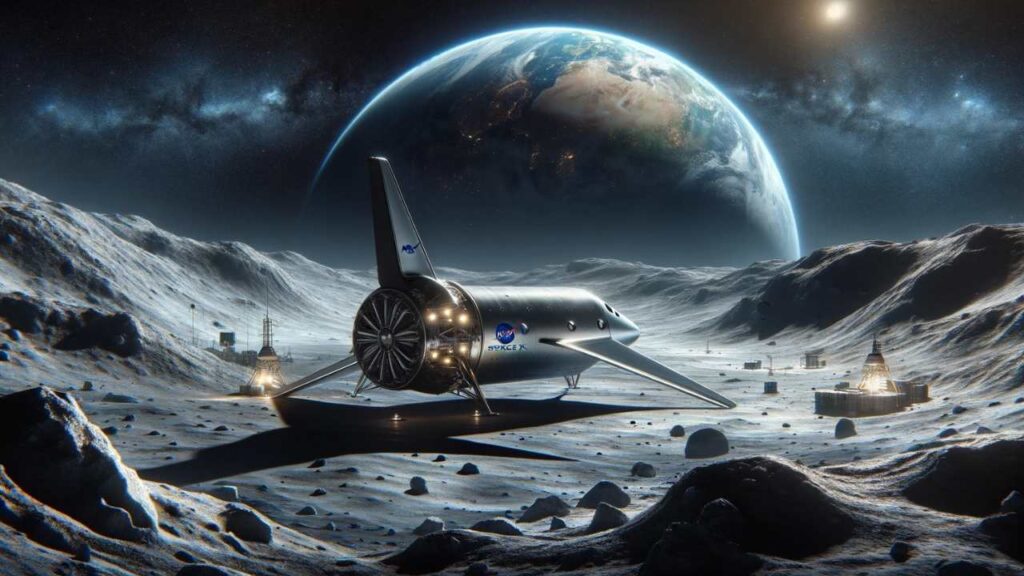“Explore how NASA’s Artemis Mission, in collaboration with SpaceX’s Starship, is setting the stage for the next generation of lunar exploration and beyond. Learn about the groundbreaking technologies and missions aimed at establishing a sustainable human presence on the Moon and preparing for future expeditions to Mars.”

NASA’s Artemis Mission
NASA’s ambitious Artemis program aims to usher in a new era of lunar exploration, promising to bring humans back to the Moon with a vision that benefits all of humanity. In a significant collaboration, NASA has joined forces with SpaceX to develop the latter’s Starship as the Human Landing System (HLS) for the Artemis III and Artemis IV missions. These missions are set to make history by landing astronauts near the Moon’s South Pole, a region never before explored by humans.
SpaceX’s Milestone Flight Test
On March 14, SpaceX achieved a critical milestone in its partnership with NASA by conducting the third integrated flight test of its Super Heavy booster coupled with the Starship upper stage. This test, launched from SpaceX’s Starbase launch pad at 8:25 a.m. CDT, plays a crucial role in advancing the Starship HLS toward operational readiness for the Artemis missions. The launch was propelled by the Super Heavy booster’s 33 Raptor engines, fueled by a cutting-edge combination of super-cooled liquid methane and liquid oxygen. Following a hot-staging technique, Starship, equipped with six Raptor engines, successfully separated from the booster, marking a significant achievement in the mission’s flight plan.
Advancing Objectives with Ambitious Flight Tests
Each flight test SpaceX undertakes is designed to push the boundaries of what is possible with Starship, providing valuable lessons for future mission systems development. According to Lisa Watson-Morgan, HLS Program Manager at NASA’s Marshall Space Flight Center, these tests are instrumental in gathering essential data for Starship HLS’s continuous development. The recent flight test not only achieved its expected objectives, including reaching orbit and completing a full-duration ascent burn, but also marked several firsts in the spacecraft’s development trajectory.
Innovations in Cryogenic Propellant Transfer
A key aspect of the test was demonstrating the transfer of cryogenic propellant between internal tanks, a critical operation for future Artemis missions. This demonstration, part of NASA’s Space Technology Missions Directorate 2020 Tipping Point awards, represents a groundbreaking step in space exploration technology. Analyzing flight test data will provide insights into the management of super-cooled propellant, a challenge never before tackled on this scale.
Enhancing Deep Space Exploration
The Artemis program, through collaborations like the one with SpaceX, is laying the groundwork for not just lunar exploration, but also human expeditions to Mars and beyond. The development of commercial human landing systems, alongside technologies such as the Space Launch System rocket, Orion spacecraft, advanced spacesuits, and rovers, marks a transformative era in space exploration. With the goal of landing the first woman and the first person of color on the Moon, as well as incorporating international partner astronauts, Artemis is poised to expand humanity’s presence in the solar system, paving the way for the future of exploration.
Expanding Human Horizons: The Role of Starship in Lunar Missions
The collaboration between NASA and SpaceX introduces Starship, a fully reusable spacecraft designed to transport humans and cargo to the Moon, Mars, and beyond. This partnership underlines a strategic shift towards leveraging commercial capabilities for government-led space exploration efforts. The development of Starship as the Human Landing System (HLS) for the Artemis missions is not just a technical achievement but also a cornerstone for sustainable lunar exploration strategies.

Pioneering Technologies for Deep Space Missions
The integration of SpaceX’s Starship into NASA’s Artemis program is a testament to the innovative spirit driving current space exploration. The recent successful flight test of the Super Heavy booster and Starship upper stage is a pivotal moment, showcasing the technological advancements made towards creating a reliable and efficient lunar landing system. The use of super-cooled liquid methane and liquid oxygen as propellants not only represents a breakthrough in rocket fuel technology but also demonstrates the potential for in-situ resource utilization in future Mars missions.
The Significance of Cryogenic Propellant Management
The ability to store and transfer cryogenic propellant in space is a critical component of extending human presence deeper into the solar system. The challenges associated with managing these super-cooled liquids in microgravity conditions are immense, involving complex physics and engineering solutions. The recent flight test provided a unique opportunity to validate technologies essential for propellant transfer, crucial for the success of long-duration space missions and the establishment of a sustainable presence on the Moon and Mars.
Preparing for the Future: Artemis and Beyond
NASA’s Artemis program is more than a series of missions to the Moon; it is a blueprint for the future of human exploration of the solar system. The program’s objectives extend far beyond landing the next man and the first woman on the lunar surface; they include establishing a sustainable human presence on the Moon by the end of the decade. This ambitious goal will serve as a stepping stone for the next giant leap: sending astronauts to Mars.
Commercial partnerships, like the one with SpaceX, play a crucial role in this vision, bringing innovation, efficiency, and sustainability to space exploration. The development of technologies such as the Starship HLS is instrumental in overcoming the logistical and technical challenges of deep space exploration.
A New Era of Space Exploration
The collaboration between NASA and SpaceX on the Starship HLS is emblematic of the synergistic potential between government space agencies and private sector innovation. As we stand on the brink of a new era in space exploration, the successes of the Artemis program and the development of groundbreaking technologies like Starship will not only expand our understanding of the universe but also inspire future generations to dream bigger and reach further than ever before.
